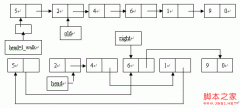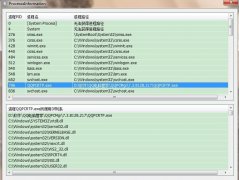使用C++ Buider制作自绘画列表框
C++ Builder中的列表框和组合框控件都已经提供了自绘画接口。使用这些接口可以实现把列表框和组合框中的项目显示为图像。假如把这种功能封装成组件就更妙了,下面以列表框为例,示范这一过程。
一 实现原理
列表框有的Style属性定义了三种风格,lbStandard风格只能显示文本,bOwner-DrawFixed与lbOwnerDrawVariable风格可以实现自绘画功能,所不同的是,具有前者风格的列表框中每一项的高度都是相同的,后者答应应用程序为每一项定义不同高度。
具有自绘画风格的列表框,在列表框的外观改变的时候,如增加,删除,滚动项目,总要触发两个事件句柄:
TMeasureItemEvent OnMeasureItem;
TDrawItemEvent OnDrawItem;
typedef void __fastcall (_closure *TDrawItemEvent)(TWinControl* Control,int Index,Trect& Rect; TOwnerDrawState State);
typedef void __fastcall(_closure* TMeasureItemEvent)(TWinControl* Control, int Index,int& Height);
OnMeasureItem事件传递一个参数Height,应用程序需要填写一项来决定这一项的高度,假如没有改变,则使用列表框的ItemHeight的值。lbOwnerDrawFixed风格的列表框不触发这一事件,故它使用自身的ItemHeight。OnDrawItem传递的Rect表示可在上作画的矩形区,程序可以使用列表框Canvas属性来画图。
二 示例
1 在IDE环境中,选择“File-New”,在对话框中双击“Component”,出现"New Component"对话框,在Ancestor Type中选择“TCustomListBox",在Class Name中输入"TImageListBox",点Create Uints,就生成一个类框架。
2 在头文件(ImageListBox.h)中的相应域中,增加下列成员:
private:
Graphics::Tgraphic* tmpGraphic;
protected:
void __fastcall MyDrawItem(TWinControl *Control,int Index, const Trect &Rect,TOwnerDrawState State);
void __fastcall MyMeasureItem(TWinControl *Control,int Index, int &Height);
public:
__fastcall TImageListBox(Tcomponent* Owner);
__fastcall ~TImageListBox();
void __fastcall AddImage(System::AnsiString Filename,System::AndiString* String);
…
3.在实现文件(ImageListBox.cpp)定义以下函数:
void __fastcall TImageListBox::MyMeasureItem(TWinControl *Control,int Index, int &Height)
{
if(tmpGraphic)
Height=tmpGraphic->Height+2;
//因为C++ Builder中的列表框封装了LBS_HASSTRINGS特性,所以在这个事
//件中不能采用诸如Items->Objects[Index]形式来取得图像数据。
}
void __fastcall TImageListBox::MyDrawItem(TWinControl *Control,int Index, const Trect &Rect,TOwnerDrawState State)
{
int Offset = 2; // 定义文本与图像的距离
Tcanvas *pCanvas = ((TListBox *)Control)->Canvas;
pCanvas->FillRect(Rect); //填充方框
//取得图像对象
Tgraphic* tmpImage=(Tgraphic*)(Items->Objects[Index]);
pCanvas->Draw(Rect.Left+Offset,Rect.Top,tmpImage); //画图
if(tmpImage)Offset+=tmpImage->Width+4; //显示文本
pCanvas->TextOut(Rect.Left + Offset, Rect.Top, ((TListBox *)Control)->Items->Strings[Index]);
}
//--------------------------------------------------------------------------
void __fastcall TImageListBox::AddImage(System::AnsiString Filename,System::AnsiString* String)
{
//装载图像,并追加至Objects对象。
if(Filename.Pos(".ico"))
{
tmpGraphic=new Graphics::Ticon();
tmpGraphic->LoadFromFile(Filename);
Items->AddObject(String,(Tobject*)tmpGraphic);
}
else if(Filename.Pos(".bmp"))
{
tmpGraphic=new Graphics::Tbitmap();
tmpGraphic->LoadFromFile(Filename);
Items->AddObject(String,(Tobject*)tmpGraphic);
}
tmpGraphic=NULL;
}
__fastcall TImageListBox::TImageListBox(Tcomponent* Owner):TCustomListBox(Owner)
{
Style=lbOwnerDrawVariable;
OnDrawItem=MyDrawItem;
OnMeasureItem=MyMeasureItem;
}
__fastcall TImageListBox::~TImageListBox()
{ //释放图像资源
for(int i=0;iCount;i++)
{
if((tmpGraphic=(Tgraphic*)Items->Objects[i])!=NULL)
delete tmpGraphic;
}
}
三 测试组件
新建一个工程,先在工程中添加刚才建立的ImageListBox.cpp,并在主窗体的头文件(.h)及实现文件(.cpp)中增加#include "Imagelistbox.h". 然后在private域中增加一个成员:
TImageListBox* Til;
在窗体的构造函数中增加如下代码:
Til=new TImageListBox(this);
Til->Parent=this;
Til->Width=80;
Til->Height=90;
Til->AddImage("1.ico","First");
Til->AddImage("2.bmp,"Second");
…
在窗体的析构函数中增加一句:“delete Til;”,运行程序。
以上代码在Windows 95 OSR2 ,C++ Builder 3.0中编译测试通过。读者可以自行修改,使功能更加完善。
- 上一篇:几种vcl构件的用法
- 下一篇:C++操作符重载的变态用途之子类转换





